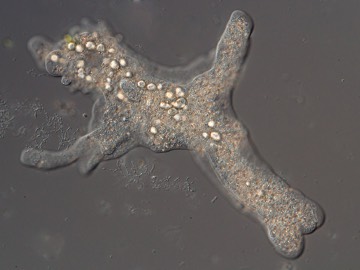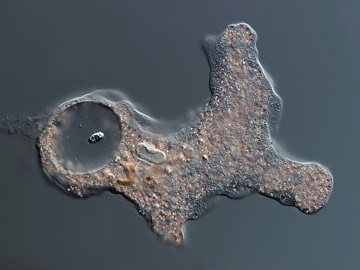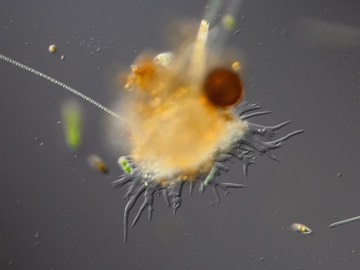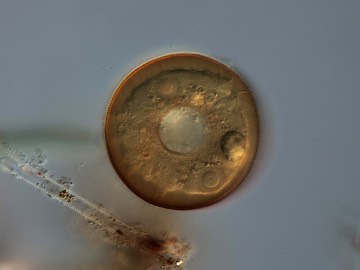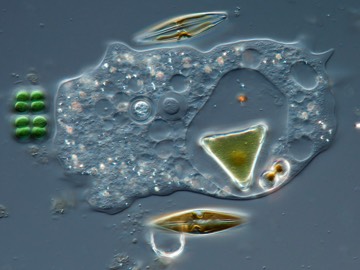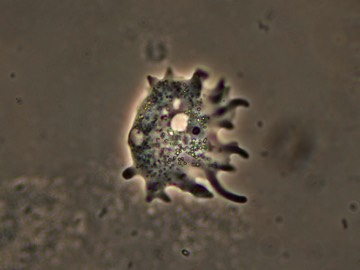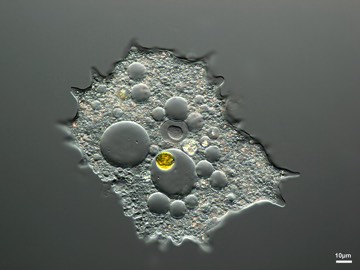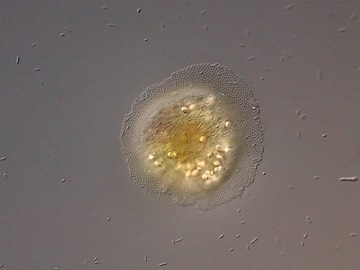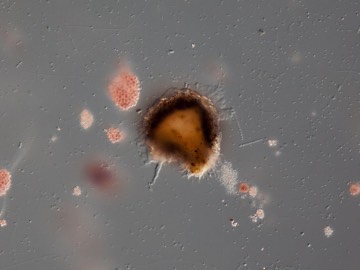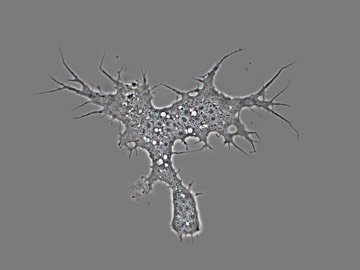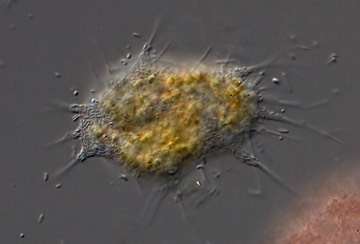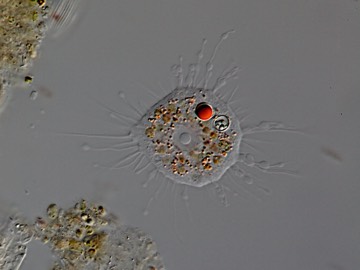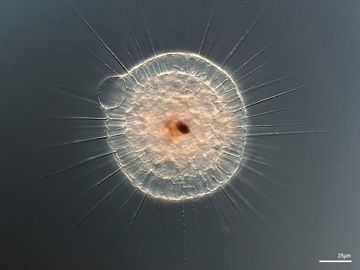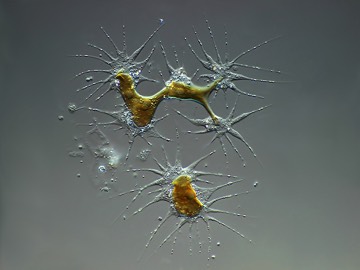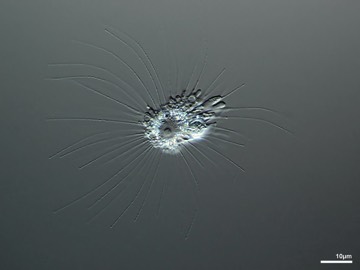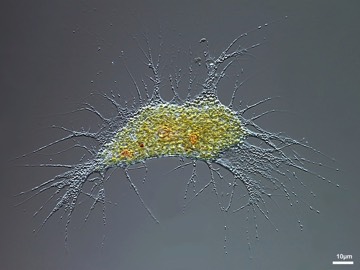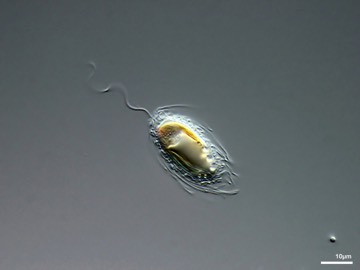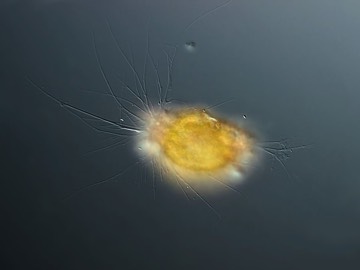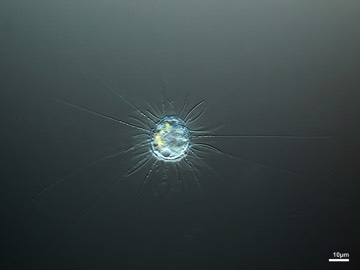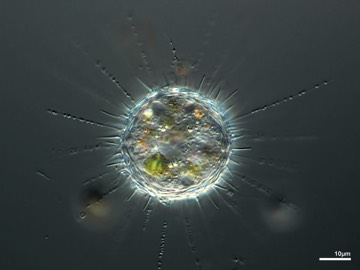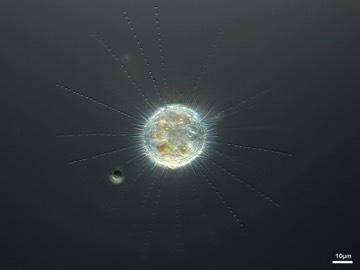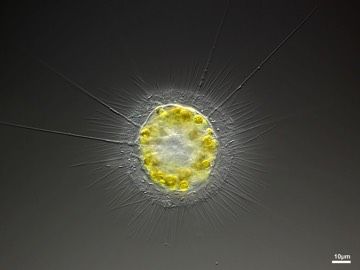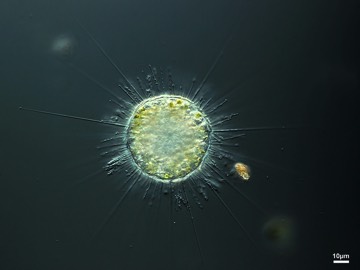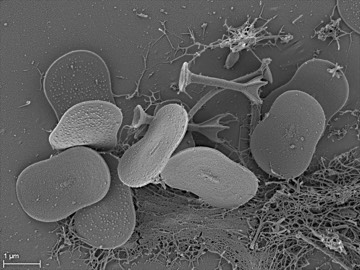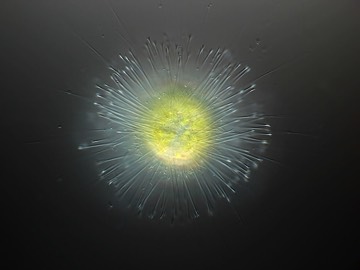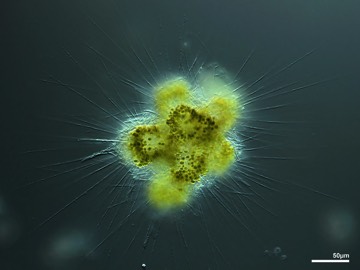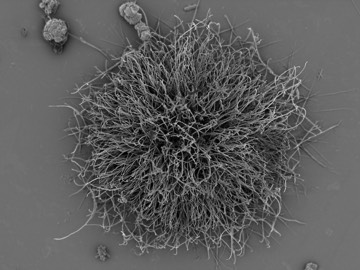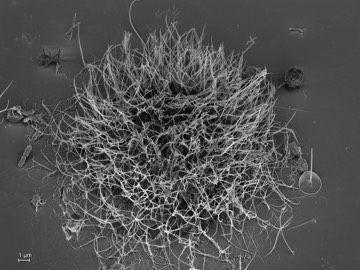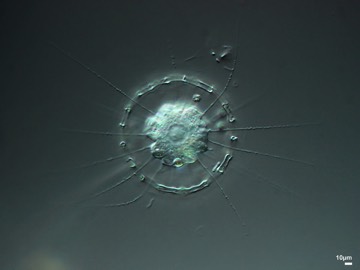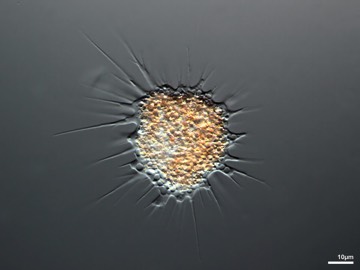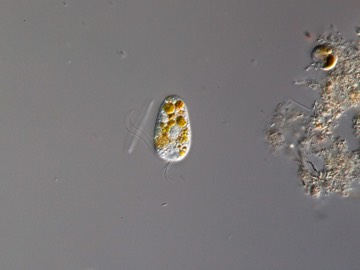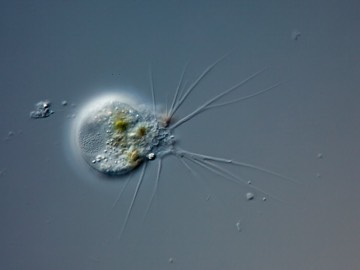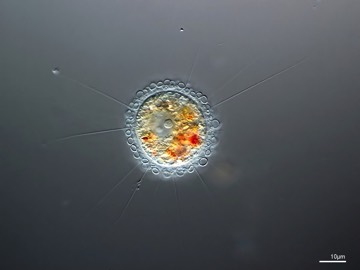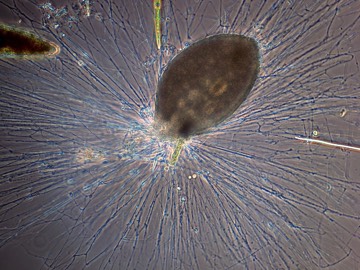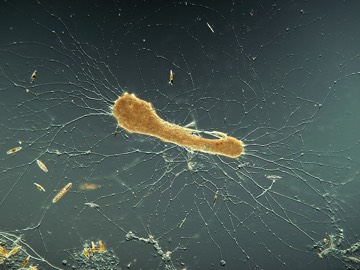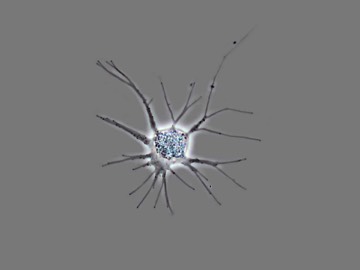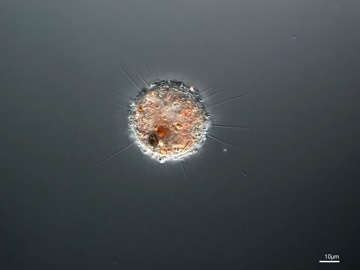Amoebozoa Lühe 1913, emend. Cavalier-Smith 1998
Cells naked or testate, uni-, bi- and multinucleate, cysts common, sexual or asexual, pseudopodia of the lobopodia type. Details
Cells naked or testate, uni-, bi- and multinucleate, cysts common, sexual or asexual, pseudopodia of the lobopodia type. Details
- Tubulinea[+]Tubular, sub cylindrical pseudopodia or capable of altering the locomotive form from a flattened, expanded one to a sub cylindrical one. Monoaxial flow of the cytoplasm in every pseudopodium or in the entire cell. Details
- Euamoebida[+]Naked with subcylindrical pseudopodia in locomotion (or the entire cell is monopodial and subcylindrical); without alteration of the locomotive form to a flattened expanded and branched one; without adhesive uroid; glycocalyx amorphous, filamentous or consisting of prismatic, cup-shaped structures.
Including: Amoeba, Chaos, Hartmannella, Parachaos, Polychaos.
Gallery - Leptomyxida[+]Naked with locomotive form altering from a flattened expanded or reticulate one, when slowly moving, to a subcylindrical monopodial one when in rapid movement or under specific conditions; adhesive uroid.
Including: Rhizamoeba, Leptomyxa
Gallery - Arcellinida[+]Testate, inside an organic or mineral extracellular test of either self-secreted elements (calcareous, siliceous, or chitinoid) or recycled mineral or diatom particles bound together, with a single main opening.
Gallery
- Discosea[+]Flattened naked amoebae that never produce tubular, sub cylindrial pseudopodia and never alter their locomotive form. Cytoplasmic flow polyaxial or without a pronounced axis. Subpseudopodia short or absent. Details
- Flabellinia[+]Flattened generally fan-shaped, discoid or irregularly triangular, never with pointed subpseudopodia or centrosomes.
Gallery - Longamoebia[+]
- Himatismenida[+]
- Pellitida[+]Cell coat envelops the entire cell and is integrated with the cell membrane. For locomotion and phagocytosis amoebae produce short subpseudopodia protruding through the cell coat and covered at the distal end solely by the cell membrane.
Gallery
- Variosea[+]
Aerobic ciliated amoebae with conical microtubular cytoskeleton and only temporary pointed pseudopodia or non-ciliate amoebae with long, tapering, usually pointed, often branched subspseudopodia.
Gallery - Archamoebae[+]Anaerobic or microaerobic mostly ciliated amoebae with reduced mitochondrial organelles and endosymbiotic bacteria. Amoeboid movement with eruptive lobopodia. Free-living or endobiotic.
Gallery
Nucletmycea Brown et al. 2009
This is a group that includes Fungi, Nuclearia Cienkowski 1865 and Fonticula Worley et al. 1979. Some nucleariid amoebae often show axopodia-like pseudopodia. Nucleariids have no axonemes and no kinetocysts.
This is a group that includes Fungi, Nuclearia Cienkowski 1865 and Fonticula Worley et al. 1979. Some nucleariid amoebae often show axopodia-like pseudopodia. Nucleariids have no axonemes and no kinetocysts.
Stramenopiles Patterson 1989, emend. Adl et al. 2005
Motile cells typically biciliate, typically with heterokont ciliation – anterior cilium with tripartite mastigonemes in two opposite rows and a posterior usually smooth cilium. Details
Motile cells typically biciliate, typically with heterokont ciliation – anterior cilium with tripartite mastigonemes in two opposite rows and a posterior usually smooth cilium. Details
- Actinophryidae[+]Ciliated cells absent. Axonemal pseudopodia with stiff microtubular core (axopodia). Axopodia originate from an amorphous centrosome near nuclei. Single large central nucleus or several peripheral nuclei.
Including: Actinophrys, Actinosphaerium.
Gallery - Chrysophyceae[+]Predominantely ciliated cells, swimming cells biciliated. Cell coverings, when present, include organic scales, siliceous scales, organic lorica, and cellulose cell wall; eyespots present or absent. With statospores.
Including: Dinobryon, Epipyxis, Cyclonexis, Chrysostephanosphaera, Chrysamoeba, Lagynion, Paraphysomonas.
Gallery - Dictyochophyceae[+]Single cells, colonial ciliated cells or amoebae; swimming cells usually with one cilium, anteriorly directed. Cells naked, with organic scales or with siliceous skeleton; eyespots absent.
Including: Ciliophrys, Palatinella.
Gallery - Picophagophyceae[+]Naked plasmodium with finely branched filopodia and yellowish-green plastids and multiple vesicular nuclei.
Including: Chlamydomyxa.
Gallery - Synurales[+]Predominantely ciliated cells, benthic palmelloid colonies known; swimming cells usually with two anteriorly directed cilia. Cells covered with bilaterally symmetrical silica scales; eyespots absent; statospores.
Including: Synura, Mallomonas.
Gallery - Labyrinthulomycetes[+]Mainly osmotrophic cells capable of producing an ectoplasmic network of branched, anastomosing, wall-less filaments via a specialized organelle known as the bothrosome; Golgi-derived scales; biciliate zoospores with lateral insertion in many species.
Including: Amphitrema, Diplophrys.
Gallery
Centrohelea Kühn 1926, stat. n. Cavalier-Smith 1993
Non-flagellate heliozoa with axopodial axonemes; nucleus eccentric; centrosome central; two types of siliceous scales present ancestrally (flat inner tangential plate scales and elongated, usually pointed, outer radial spine scales), but outer scales or both scale layers secondarily lost in several derived lineages. Details
Non-flagellate heliozoa with axopodial axonemes; nucleus eccentric; centrosome central; two types of siliceous scales present ancestrally (flat inner tangential plate scales and elongated, usually pointed, outer radial spine scales), but outer scales or both scale layers secondarily lost in several derived lineages. Details
- Pterocystida[+]Silicified species always with both plate and spine scales; plate scales oval without an inrolled margin; spine scales (spicules) radially asymmetric, ranging from a shape like a pointed moss leaf with axial rib, through reduced forms with the blade restricted to the base, to a vertical stalk emanating from a notched asymmetric basal disc.
- Pterocystidae[+]Periplast ancestrally with two contrasting types of siliceous scales: tangential basal plate scales; outer bipartite radial spine scales, usually extended apically as a projecting needle-like point.
Including: Pterocystis, Raineriophrys, Chlamydaster, Echinocystis.
Gallery - Choanocystidae[+]Periplast with two contrasting types of siliceous scales, oval or bilobed tangential basal plate scales; outer bipartite radial spine scales consisting of a vertical stalk, sometimes curved or branched but lacking lateral wings. Funnel-shaped scales absent.
Including: Choanocystis.
Gallery - Heterophryidae[+]Centrohelids lacking silica scales but with numerous thin pointed organic scales tapering towards acute apices.
Including: Heterophrys, Sphaerastrum, Parasphaerastrum.
Gallery
- Acanthocystida[+]Silicified species with both plate and spine scales or only plate scales lacking a hollow inrolled margin; outer radial spine scales radially symmetric, present in one or both of two forms: funnel-shaped with apical flared and toothed funnel on a stalk and a discoid base, or needle-like with a radially symmetric peltate base and/or apical branches.
- Chalarothoracina[+]
- Acanthocystidae[+]Periplast with two or three types of siliceous scales, a basal layer of typically oval plate scales and an outer layer of radial funnel-shaped siliceous spine scales and/or radial needle-like spine scales sometimes apically branched and/or with a peltate radially symmetrical basal disc lacking a lateral indentation.
Including: Acanthocystis, Raphidocystis, Pseudoraphidocystis.
Gallery - Raphidiophryidae[+]Periplast typically containing tangential siliceous plates surrounded by a hollow marginal rim but never goblet-shaped or other radial spine scales.
Including: Raphidiophrys, Pseudoraphidiophrys, Polyplacocystis, Heteroraphidiophrys.
Gallery
- Marophryina[+]
Cercozoa Cavalier-Smith 1998, emend. Adl et al. 2005
This is a group of flagellates and amoebae defined by molecular phylogenies. The amoeboid genera have either filose pseudopodia (filopodia) or networks of anastomosing reticulopodia. Very often with cysts. Details
This is a group of flagellates and amoebae defined by molecular phylogenies. The amoeboid genera have either filose pseudopodia (filopodia) or networks of anastomosing reticulopodia. Very often with cysts. Details
- Granofilosea[+]With very delicate reticulopodia bearing frequent regular extrusomes.
Including: Clathrulina, Microgromia, Apogromia, Microcometes, Paralieberkuehnia.
Gallery - Vampyrellida[+]Naked, phagotrophic amoeboid organisms; amoeboid, free-moving trophozoites alternating with an obligatory digestive cyst.
Including: Vampyrella, Leptophrys, Hyalodiscus.
Gallery - Glissomonadida[+]Small (<15 µm), naked biflagellate cells, bacterivorous or algaevorous.
Including: Viridiraptor.
Gallery - Thecofilosea[+]Ancestrally with robust organic extracellular theca; theca with perforations for cilia and for pseudopodia; ventral filose pseudopodia emerge from ventral groove.
Including: Diaphoropodon, Lecythium, Lithocolla.
Gallery - Imbricatea[+]Cells with secreted surface silica scales.
Including: Euglypha, Trinema, Cyphoderia, Paulinella, Pinaciophora, Pompholyxophrys.
Gallery
Foraminifera d’Orbigny 1826
Filopodia with granular cytoplasm, forming branching and anastomosing network (reticulopodia); bidirectional rapid (10 mm/s) transport of intracellular granules. With some exceptions this is a large taxon of marine species.
Filopodia with granular cytoplasm, forming branching and anastomosing network (reticulopodia); bidirectional rapid (10 mm/s) transport of intracellular granules. With some exceptions this is a large taxon of marine species.
- Monothalamids[+]Single chamber test with an organic or agglutinated wall or no test at all.
- Allogromiidae[+]Test globular to ovate with single, terminal aperture. Cell wall proteinaceous, sometimes incorporating agglutinated particles.
Gallery - Recticulomyxidae[+]Large plasmodia with hundreds or thousands of small nuclei involved in bidirectional streaming. Obligatory alternation of sessile and motile stages. Locomotion by migration via one or several giant pseudopodia with predominantly unidirectional centrifugal streaming of protoplasm. Cyst formation. Tectum as (protective) covering. Occasional formation of protoplasmic propagules (blisters, blebs) from pseudopodia and central areas. Omnivorous or predatory. Occurring in freshwater habitats.
Gallery
Twilight Zone
Unidentified amoebae and amoebae where the phylogenetic placement is unknown.
Unidentified amoebae and amoebae where the phylogenetic placement is unknown.
